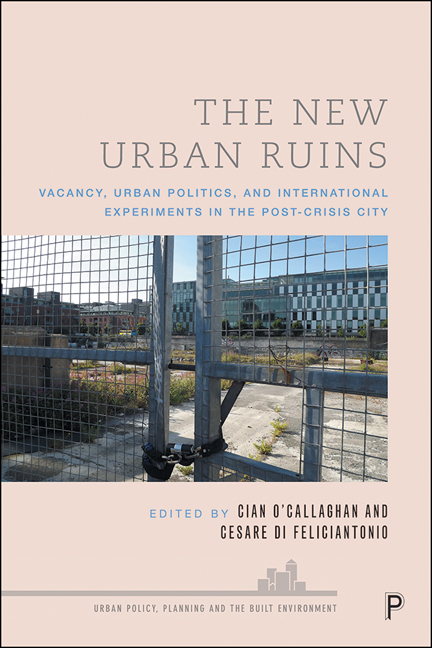Book contents
- Frontmatter
- Contents
- List of figures and tables
- Notes on contributors
- Acknowledgements
- Introduction
- PART I Rethinking ruination in the post-crisis context
- PART II The political economy of urban vacant space
- PART III Reappropriating urban vacant spaces
- Conclusion: Centring vacancy – towards a research agenda
- Index
3 - Traversing wastelands: reflections on an abandoned railway yard
Published online by Cambridge University Press: 13 May 2022
- Frontmatter
- Contents
- List of figures and tables
- Notes on contributors
- Acknowledgements
- Introduction
- PART I Rethinking ruination in the post-crisis context
- PART II The political economy of urban vacant space
- PART III Reappropriating urban vacant spaces
- Conclusion: Centring vacancy – towards a research agenda
- Index
Summary
Introduction
A long patch of vacant land appears through the windows of the train moving from the airport to the centre of Berlin. This linear zone of grasslands stretches alongside the tracks passing through the south-eastern district of Schöneweide. A former roundhouse drifts by, followed by a derelict brewery covered in shrubs and a banner appealing to ‘leave no one behind’. Traversing Berlin's track wilderness has long stirred the imagination of artists and filmmakers. In the 1981 film Berliner Stadtbahnbilder, the German writer and director Alfred Behrens secretly captured his train journeys across the divided city. The film portrays a marooned transport network of geopolitically induced disrepair: deserted platforms and defunct tracks overgrown by birch trees; a railway landscape suspended in time; or, as Behrens describes it, ‘a post-industrial wilderness at the heart of the city’.
Over the past two decades, patches of this urban wilderness have been absorbed into prize-winning public parks. An example includes the Natur-Park Südgelände in Schöneberg that opened in May 2000 – an abandoned railway yard that was designated a nature reserve and conservation area, with grassland biotopes and wild-growing woodlands (Kowarik and Langer, 2005). Another example, which has been widely celebrated in the field of landscape design, is Park am Gleisdreieck in Kreuzberg, completed in 2013. The park design evokes a new type of ‘wasteland aesthetic’ (Gandy, 2013: 1306) by integrating Gleiswildnis (‘track wilderness’), as signs label the remnants of wild forest, with various leisure and sports facilities.
Other abandoned railway zones, notably, those in more peripheral locations in the former East Berlin, have remained hidden and, until recently, attracted little public curiosity. However, with increasing pressure on land development, the track wilderness north and south-east of the city centre in boroughs like Pankow and Treptow-Köpenick is gradually being razed for speculative interests. The corporate seizure of Stadtbrachen (the German word for urban fallow or wasteland) now extends to the smallest vestiges alongside the tracks. The financialisation of the city that is reshaping Berlin's housing sector (Fields and Uffer, 2016) visibly seeps into the realm of urban nature.
- Type
- Chapter
- Information
- The New Urban RuinsVacancy, Urban Politics, and International Experiments in the Post-Crisis City, pp. 53 - 72Publisher: Bristol University PressPrint publication year: 2021

